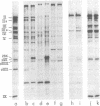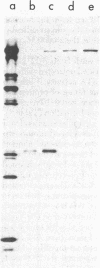Abstract
Cells transformed by simian virus 40 (SV40) possess a tumor-specific transplantation antigen (TSTA) that has the property of immunizing animals against syngeneic tumor challenge. We find that the early SV40 DNA segment present in the human adenovirus 2 (Ad2)-SV40 hybrid, Ad2+ND1, is sufficient to induce this SV40-specific TSTA in BALB/c mice. Moreover, studies on the intracellular distribution of TSTA activity in Ad2+ND1-infected cells, as determined by the ability of various subcellular fractions to immunize mice against syngeneic tumor challenge, have suggested a correlation between this biological activity and the presence of the SV40-specific 28,000Mr protein in coded by this hybrid virus. Both the TSTA activity and the 28,000 Mr protein are found in the plasma membrane fraction and in the perinuclear region of infected cells but are virtually undetectable in the cytoplasmic fraction. Using a hamster antitumor antiserum that can specifically immunoprecipitate the 28,000 Mr protein, we are able to demonstrate a loss of TSTA activity concomitant with the removal of this SV40-coded protein. Thus, it appears that antigenic determinants responsible for SV40-specific tumor rejection in mice are contained within the 28,000 Mr protein coded for by the early SV40 DNA segment that extends from 0.17 to 0.28 map unit.
Full text
PDF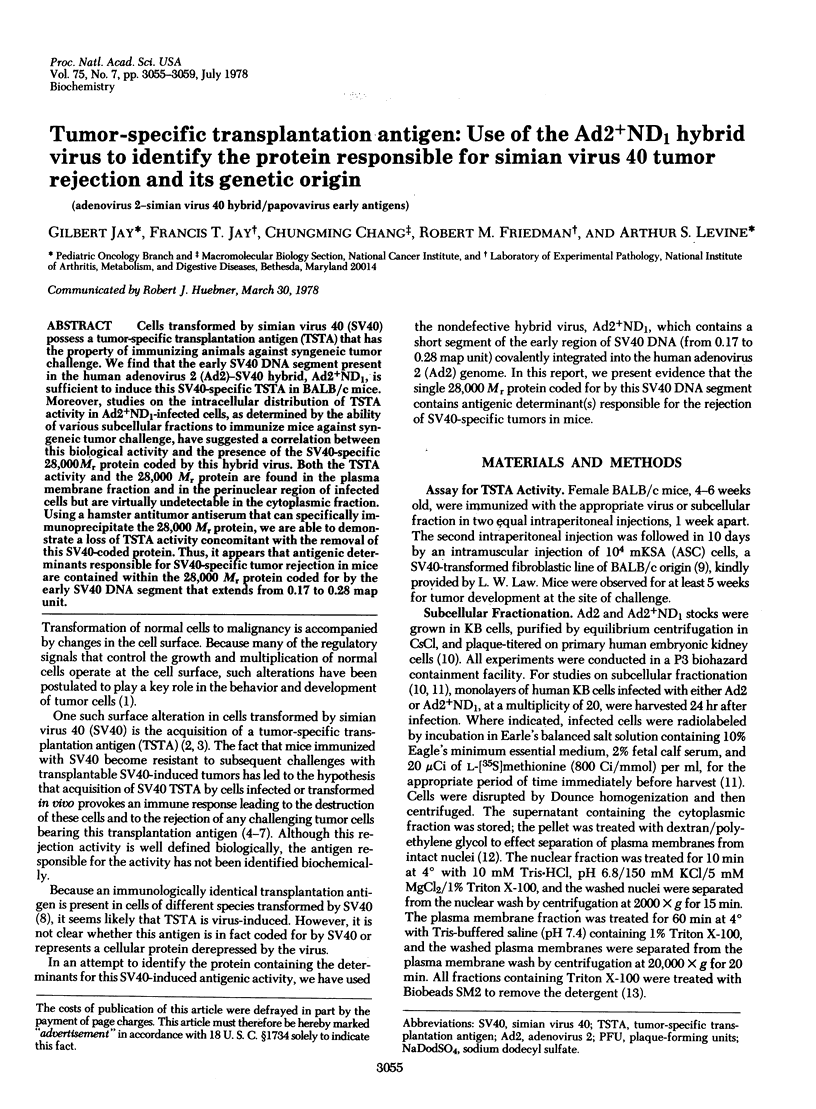
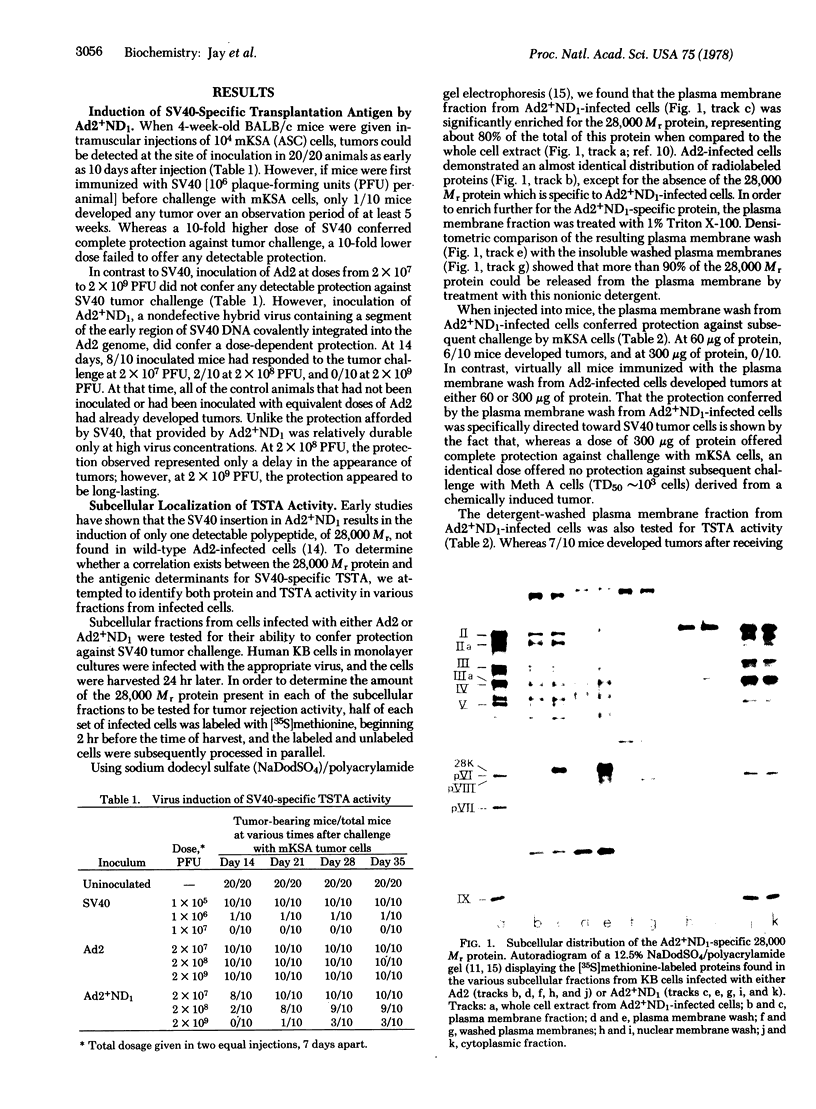
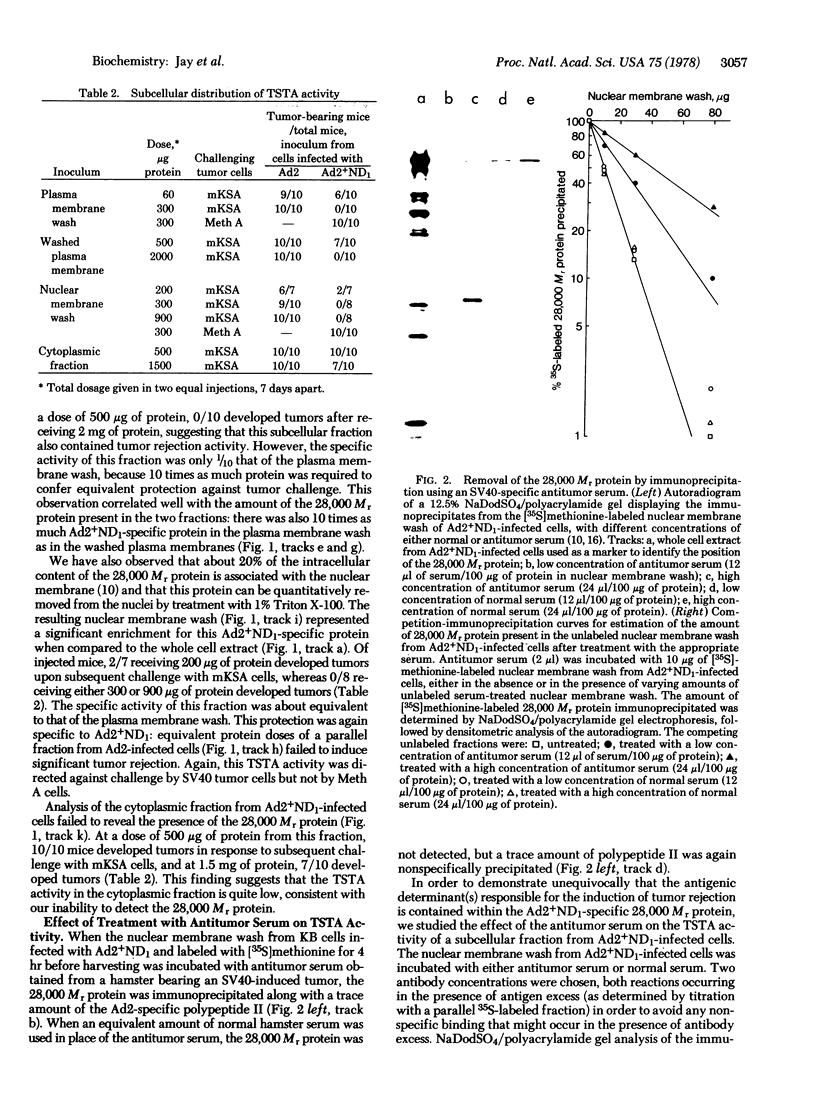
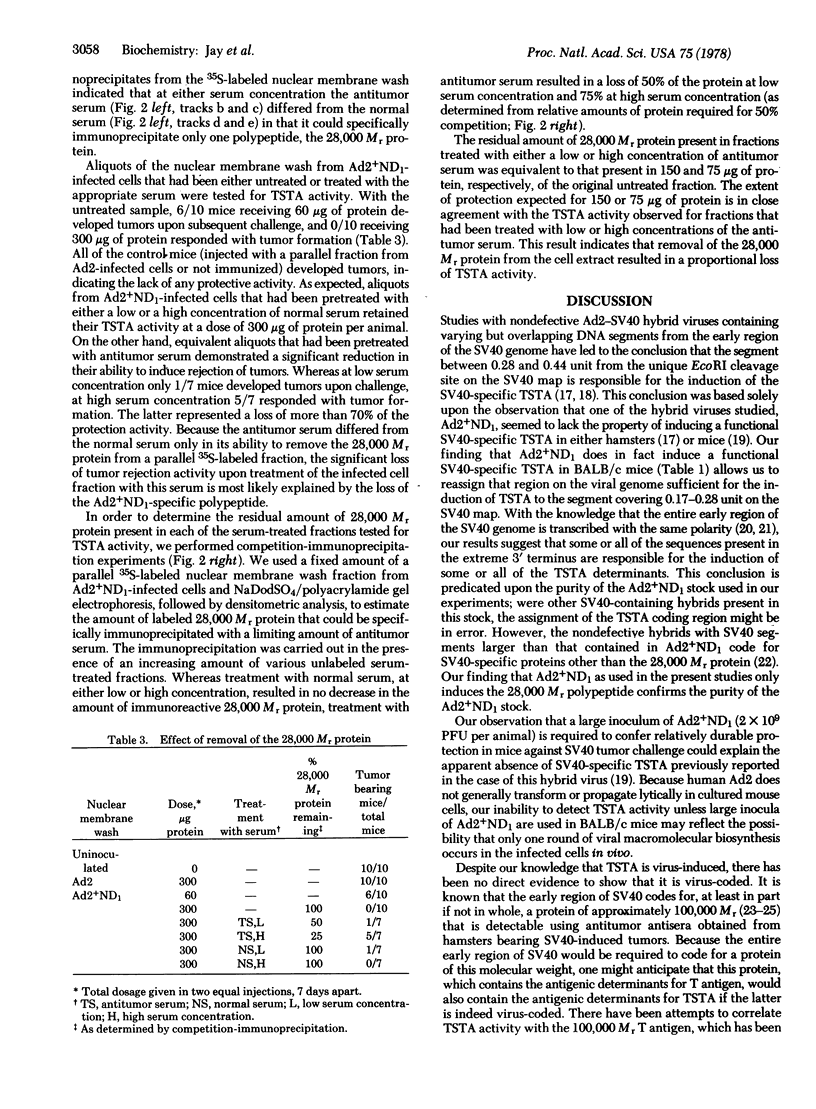
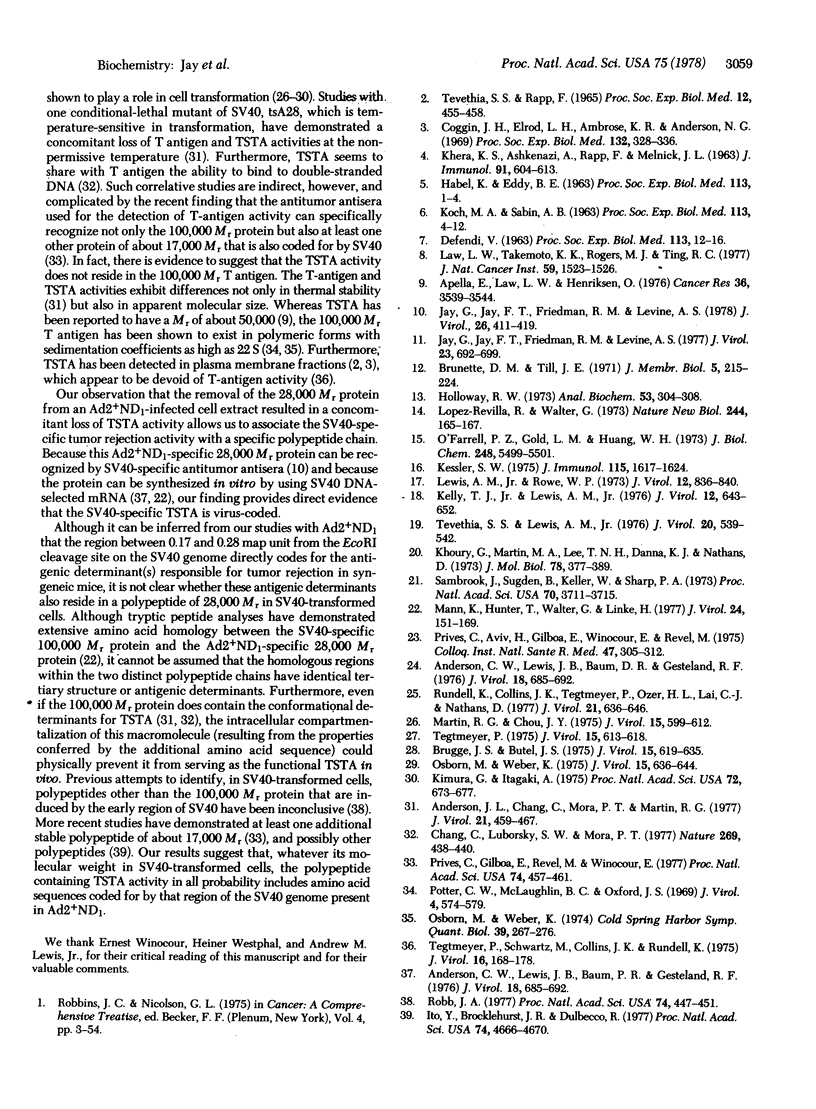
Images in this article
Selected References
These references are in PubMed. This may not be the complete list of references from this article.
- Anderson C. W., Lewis J. B., Baum P. R., Gesteland R. F. Simian virus 40-specific polypeptides in AD2+ ND1- and Ad2+ ND4-infected cells. J Virol. 1976 May;18(2):685–692. doi: 10.1128/jvi.18.2.685-692.1976. [DOI] [PMC free article] [PubMed] [Google Scholar]
- Anderson C. W., Lewis J. B., Baum P. R., Gesteland R. F. Simian virus 40-specific polypeptides in AD2+ ND1- and Ad2+ ND4-infected cells. J Virol. 1976 May;18(2):685–692. doi: 10.1128/jvi.18.2.685-692.1976. [DOI] [PMC free article] [PubMed] [Google Scholar]
- Anderson J. L., Chang C., Mora P. T., Martin R. G. Expression and thermal stability of simian virus 40 tumor-specific transplantation antigen and tumor antigen in wild type- and tsA mutant-transformed cells. J Virol. 1977 Feb;21(2):459–467. doi: 10.1128/jvi.21.2.459-467.1977. [DOI] [PMC free article] [PubMed] [Google Scholar]
- Appella E., Law L. W., Henriksen O. Biological and biochemical properties of soluble tumor-specific transplantation antigen of a simian virus 40-induced neoplasm. Cancer Res. 1976 Sep;36(9 Pt 2):3539–3544. [PubMed] [Google Scholar]
- Chang C., Luborsky S. W., Mora P. T. Tumour-specific transplantation antigen from SV40 transformed cells binds to DNA. Nature. 1977 Sep 29;269(5627):438–440. doi: 10.1038/269438a0. [DOI] [PubMed] [Google Scholar]
- Coggin J. H., Elrod L. H., Ambrose K. R., Anderson N. G. Induction of tumor-specific transplantation immunity in hamsters with cell fractions from adenovirus and SV40 tumor cells. Proc Soc Exp Biol Med. 1969 Oct;132(1):328–336. doi: 10.3181/00379727-132-34208. [DOI] [PubMed] [Google Scholar]
- DEFENDI V. Effect of SV 40 virus immunization on growth of transplantable SV 40 and polyoma virus tumors in hamsters. Proc Soc Exp Biol Med. 1963 May;113:12–16. doi: 10.3181/00379727-113-28261. [DOI] [PubMed] [Google Scholar]
- HABEL K., EDDY B. E. Specificity of resistance to tumor challenge of polyoma and SV 40 virus-immune hamsters. Proc Soc Exp Biol Med. 1963 May;113:1–4. doi: 10.3181/00379727-113-28259. [DOI] [PubMed] [Google Scholar]
- Holloway P. W. A simple procedure for removal of Triton X-100 from protein samples. Anal Biochem. 1973 May;53(1):304–308. doi: 10.1016/0003-2697(73)90436-3. [DOI] [PubMed] [Google Scholar]
- Jay G., Jay F. T., Friedman R. M., Levine A. S. Biosynthesis, immunological specificity, and intracellular distribution of the simian virus 40-specific protein induced by the nondefective hybrid Ad2+ND1. J Virol. 1978 May;26(2):411–419. doi: 10.1128/jvi.26.2.411-419.1978. [DOI] [PMC free article] [PubMed] [Google Scholar]
- Jay G., Jay F. T., Friedman R. M., Levine A. S. Simian virus 40-specific ribosome-binding proteins induced by a nondefective adenovirus 2-simian virus 40 hybrid. J Virol. 1977 Sep;23(3):692–699. doi: 10.1128/jvi.23.3.692-699.1977. [DOI] [PMC free article] [PubMed] [Google Scholar]
- KHERA K. S., ASHKENAZI A., RAPP F., MELNICK J. L. IMMUNITY IN HAMSTERS TO CELLS TRANSFORMED IN VITRO AND IN VIVO BY SV40. TESTS FOR ANTIGENIC RELATIONSHIP AMONG THE PAPOVAVIRUSES. J Immunol. 1963 Nov;91:604–613. [PubMed] [Google Scholar]
- KOCH M. A., SABIN A. B. Specificity of virus-induced resistance to transplantation of polyoma and SV 40 tumors in adult hamsters. Proc Soc Exp Biol Med. 1963 May;113:4–12. doi: 10.3181/00379727-113-28260. [DOI] [PubMed] [Google Scholar]
- Kelly T. J., Jr, Lewis A. M., Jr Use of nondefective adenovirus-simian virus 40 hybrids for mapping the simian virus 40 genome. J Virol. 1973 Sep;12(3):643–652. doi: 10.1128/jvi.12.3.643-652.1973. [DOI] [PMC free article] [PubMed] [Google Scholar]
- Kessler S. W. Rapid isolation of antigens from cells with a staphylococcal protein A-antibody adsorbent: parameters of the interaction of antibody-antigen complexes with protein A. J Immunol. 1975 Dec;115(6):1617–1624. [PubMed] [Google Scholar]
- Khoury G., Martin M. A., Lee T. N., Danna K. J., Nathans D. A map of simian virus 40 transcription sites expressed in productively infected cells. J Mol Biol. 1973 Aug 5;78(2):377–389. doi: 10.1016/0022-2836(73)90123-x. [DOI] [PubMed] [Google Scholar]
- Kimura G., Itagaki A. Initiation and maintenance of cell transformation by simian virus 40: a viral genetic property. Proc Natl Acad Sci U S A. 1975 Feb;72(2):673–677. doi: 10.1073/pnas.72.2.673. [DOI] [PMC free article] [PubMed] [Google Scholar]
- Law L. W., Takemoto K. K., Rogers M. J., Ting R. C. Induction of simian virus 40 (SV40) transplantation immunity in mice by SV40-transformed cells of various species. J Natl Cancer Inst. 1977 Nov;59(5):1523–1526. doi: 10.1093/jnci/59.5.1523. [DOI] [PubMed] [Google Scholar]
- Lewis A. M., Jr, Rowe W. P. Studies of nondefective Adenovirus 2-Simian virus 40 hybrid viruses. 8. Association of Simian virus 40 transplantation antigen with a specific region of the early viral genome. J Virol. 1973 Oct;12(4):836–840. doi: 10.1128/jvi.12.4.836-840.1973. [DOI] [PMC free article] [PubMed] [Google Scholar]
- López-Revilla R., Walter G. Polypeptide specific for cells with adenovirus 2-SV40 hybrid Ad2+ND1. Nat New Biol. 1973 Aug 8;244(136):165–167. doi: 10.1038/newbio244165a0. [DOI] [PubMed] [Google Scholar]
- Mann K., Hunter T., Walter G., Linke H. Evidence for simian virus 40 (SV40) coding of SV40 T-antigen and the SV40-specific proteins in HeLa cells infected with nondefective adenovirus type 2-SV40 hybrid viruses. J Virol. 1977 Oct;24(1):151–169. doi: 10.1128/jvi.24.1.151-169.1977. [DOI] [PMC free article] [PubMed] [Google Scholar]
- Martin R. G., Chou J. Y. Simian virus 40 functions required for the establishment and maintenance of malignant transformation. J Virol. 1975 Mar;15(3):599–612. doi: 10.1128/jvi.15.3.599-612.1975. [DOI] [PMC free article] [PubMed] [Google Scholar]
- O'Farrell P. Z., Gold L. M., Huang W. M. The identification of prereplicative bacteriophage T4 proteins. J Biol Chem. 1973 Aug 10;248(15):5499–5501. [PubMed] [Google Scholar]
- Osborn M., Weber K. SV40: T antigen, the A function and transformation. Cold Spring Harb Symp Quant Biol. 1975;39(Pt 1):267–276. doi: 10.1101/sqb.1974.039.01.035. [DOI] [PubMed] [Google Scholar]
- Osborn M., Weber K. Simian virus 40 gene A function and maintenance of transformation. J Virol. 1975 Mar;15(3):636–644. doi: 10.1128/jvi.15.3.636-644.1975. [DOI] [PMC free article] [PubMed] [Google Scholar]
- Potter C. W., McLaughlin B. C., Oxford J. S. Simian virus 40-induced T and tumor antigens. J Virol. 1969 Nov;4(5):574–579. doi: 10.1128/jvi.4.5.574-579.1969. [DOI] [PMC free article] [PubMed] [Google Scholar]
- Prives C., Gilboa E., Revel M., Winocour E. Cell-free translation of simian virus 40 early messenger RNA coding for viral T-antigen. Proc Natl Acad Sci U S A. 1977 Feb;74(2):457–461. doi: 10.1073/pnas.74.2.457. [DOI] [PMC free article] [PubMed] [Google Scholar]
- Robb J. A. Identification of simian virus 40 tumor and U antigens. Proc Natl Acad Sci U S A. 1977 Feb;74(2):447–451. doi: 10.1073/pnas.74.2.447. [DOI] [PMC free article] [PubMed] [Google Scholar]
- Rundell K., Collins J. K., Tegtmeyer P., Ozer H. L., Lai C. J., Nathans D. Identification of simian virus 40 protein A. J Virol. 1977 Feb;21(2):636–646. doi: 10.1128/jvi.21.2.636-646.1977. [DOI] [PMC free article] [PubMed] [Google Scholar]
- Sambrook J., Sugden B., Keller W., Sharp P. A. Transcription of simian virus 40. 3. Mapping of "early" and "late" species of RNA. Proc Natl Acad Sci U S A. 1973 Dec;70(12):3711–3715. doi: 10.1073/pnas.70.12.3711. [DOI] [PMC free article] [PubMed] [Google Scholar]
- Tegtmeyer P. Function of simian virus 40 gene A in transforming infection. J Virol. 1975 Mar;15(3):613–618. doi: 10.1128/jvi.15.3.613-618.1975. [DOI] [PMC free article] [PubMed] [Google Scholar]
- Tegtmeyer P., Schwartz M., Collins J. K., Rundell K. Regulation of tumor antigen synthesis by simain virus 40 gene A. J Virol. 1975 Jul;16(1):168–178. doi: 10.1128/jvi.16.1.168-178.1975. [DOI] [PMC free article] [PubMed] [Google Scholar]
- Tevethia S. S., Lewis A. M., Jr Two adenovirus type 2-simian virus 40 hybrid populations that contain the entire SV40 genome differ in their ability to induce SV40 transplantation immunity in hamsters but not in mice. J Virol. 1976 Nov;20(2):539–542. doi: 10.1128/jvi.20.2.539-542.1976. [DOI] [PMC free article] [PubMed] [Google Scholar]
- Tevethia S. S., Rapp F. Demonstration of new surface antigens in cells transformed by papovavirus SV40 by cytotoxic tests. Proc Soc Exp Biol Med. 1965 Nov;120(2):455–458. doi: 10.3181/00379727-120-30561. [DOI] [PubMed] [Google Scholar]



